Get the most up-to-date data and insights into shipping volumes and the cost of freight. See how they change each month and understand the market forces behind them.
| May 2022 | Year-over-year change | 2-year stacked change | Month-to-month change | Month-to-month change (SA) | |
| Cass Freight Index - Shipments | 1.235 | -2.7% | 31.7% | 5.4% | 4.0% |
| Cass Freight Index - Expenditures | 4.287 | 27.5% | 91.1% | -4.9% | -5.9% |
| Cass Inferred Freight Rates | 3.471 | 31.0% | NA | -9.8% | -9.5% |
| Truckload Linehaul Index | 168.6 | 13.2% | 29.1% | 0.9% | -- |
The shipments component of the Cass Freight Index® rose 5.4% m/m in May (up 4.0% SA), more than recovering the 2.6% decline in April. On a tough comparison, the y/y decline worsened to 2.7%, as expected, but the result was 1% ahead of the ACT Research estimate.
Normal seasonality from here would have the shipments component back up 2% y/y in June and flat to up 1% for 2022. The news from the retail sector and in the oil markets suggest that’s probably optimistic, but at this point, it’s a pretty stable environment. No major downturn.
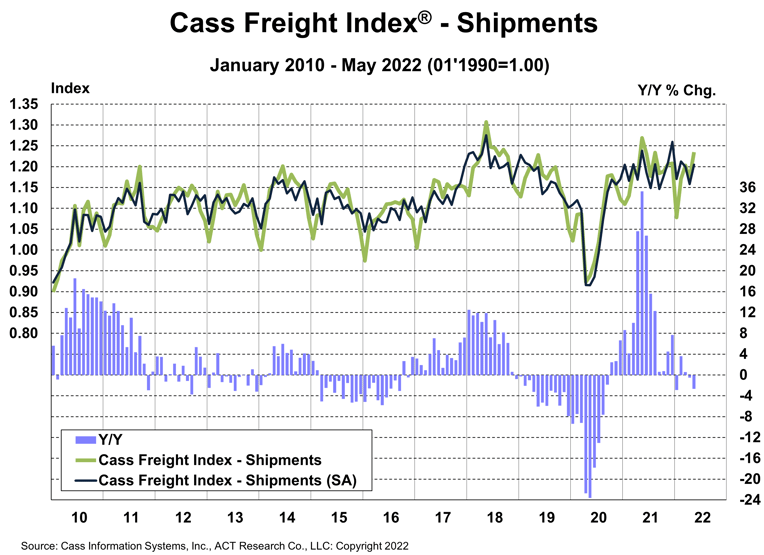
See the methodology for the Cass Freight Index.
The expenditures component of the Cass Freight Index, which measures the total amount spent on freight, fell 4.9% m/m in May with shipments up 5.4% and rates down 9.8%. The m/m noise on rates is largely mix, with more LTL and less TL in the data set, and on a y/y basis expenditures were up 28% y/y, versus a 31% increase in April.
This index rose 38% in 2021, after a 7% decline in 2020 and no change in 2019. Tougher comparisons in the coming months will naturally slow these y/y increases, particularly next month. With a normal 0.5% m/m increase, the y/y change would slow to 15% from 28% in May. And simply using normal seasonality from here, the increase in 2022 will be about 19% after a 30% increase in the first half.
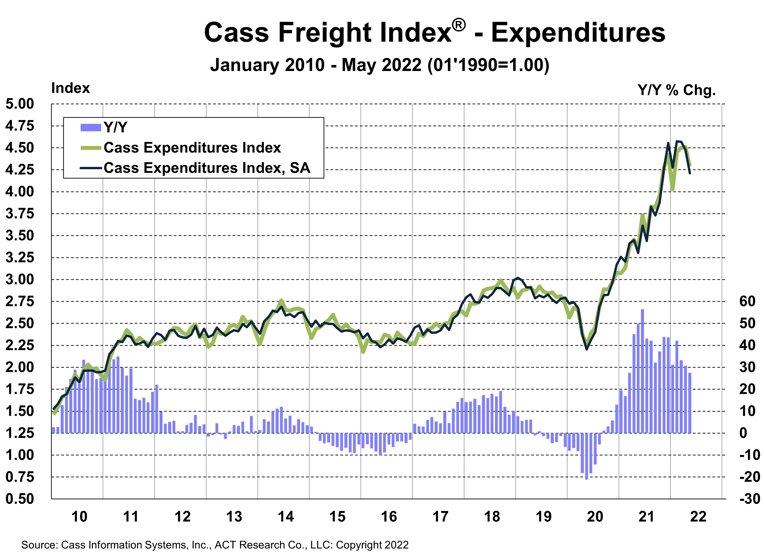
The freight rates embedded in the two components of the Cass Freight Index still rose 31% y/y in May, in line with April, despite a 9.8% m/m decline. Comps, what can we say?
It’s tempting to see this as a sign that freight costs have peaked, and on a y/y basis that is true, as inferred rates will slow all the way to 13% y/y in June on normal seasonality. Supply/demand fundamentals have certainly turned looser this year, so it wouldn’t be an unreasonable conclusion. However, as noted above, the drop was largely due to mix, and with fuel prices still adding upward pressure, the descent is not straightforward.
These rates are representative of the industry’s mix of contract and spot rates, but the 15% y/y decline in rates ex-fuel in the more real-time spot markets in early-June portends a downcycle on the horizon.
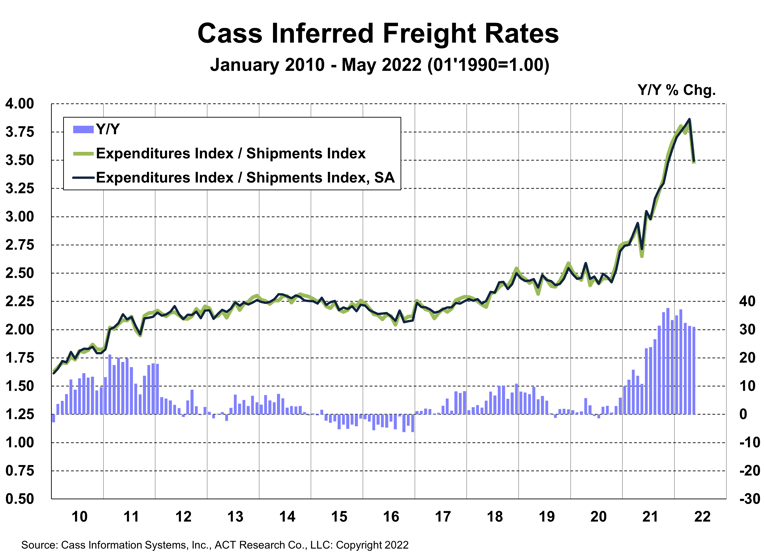
Significant risks, such as new COVID variants, remain and equipment capacity remains limited and could tighten further if the Russia/Ukraine war or China lockdowns worsen the chip shortage. But 2022 has featured a big improvement in driver availability, and a flattening of freight demand. This is a deflationary combination, though it will take several months to filter from the spot market into contract rates.
There have been tentative signs of recovering intermodal network fluidity as chassis production continues to accelerate and brisk hiring continues. Intermodal volumes continue to underperform the shipments component of the Cass Freight Index, though to a lesser degree as the latter has softened in recent months. Rail network congestion continues to add to Cass Inferred Freight Rates via excess miles in the freight network, but this effect is set to reverse as intermodal volumes are uniquely poised to grow y/y in 2H’22.
After rising 23% in 2021, the normal season pattern from here would suggest an 18% increase in 2022 inferred rates.
Cass Inferred Freight Rates are a simple calculation of the Cass Freight Index data, expenditures divided by shipments, producing a data set that explains the overall movement in cost per shipment. The data set is diversified among all modes, with truckload representing more than half of the dollars, followed by LTL, rail, parcel, and so on.
The Cass Truckload Linehaul Index® rose 13.2% y/y in May to 168.6 after rising 14.1% y/y in April.
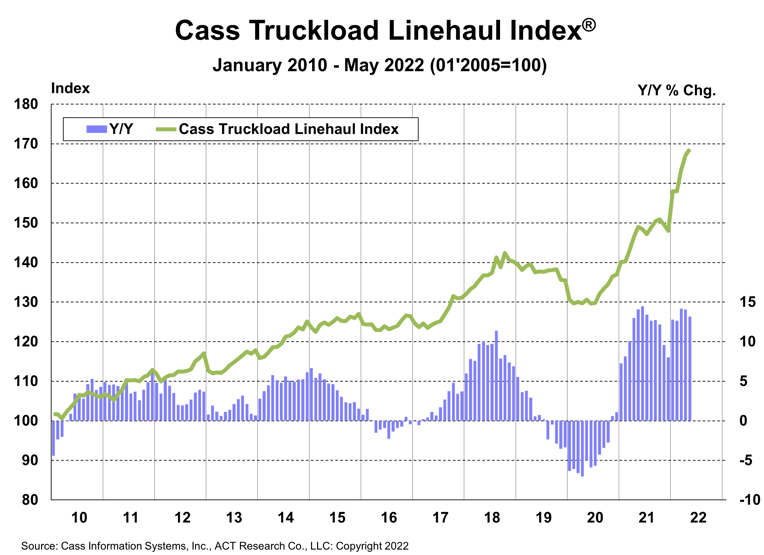
See the methodology for the Cass Truckload Linehaul Index.
Excess miles, rising fuel surcharges, and accessorial fees are all factors included in the inferred rate series, but not the Cass Truckload Linehaul Index. The true increase in freight cost, depending on how these factors shake out, is somewhere between the 14% y/y increase in the Cass Truckload Linehaul Index and the 31% y/y increase in the inferred rate. Depending on the mode, we estimate fuel costs alone are currently adding roughly 10% to the cost of freight on a y/y basis, clearly the largest part of the difference.
Growing evidence of weaker goods consumption, rising services substitution, and rebuilt inventories, with some categories now overstocked, was perhaps the most impactful news in freight this month.
Just as the freight plateau is being reinforced, trucking employment rose the most on record with 27,300 new jobs added in the past two months. The nearly 5% y/y growth rate in the BLS Truck Transportation Employment data series, along with the elevated ACT Driver Availability Index, show a very different market balance than just six months ago. 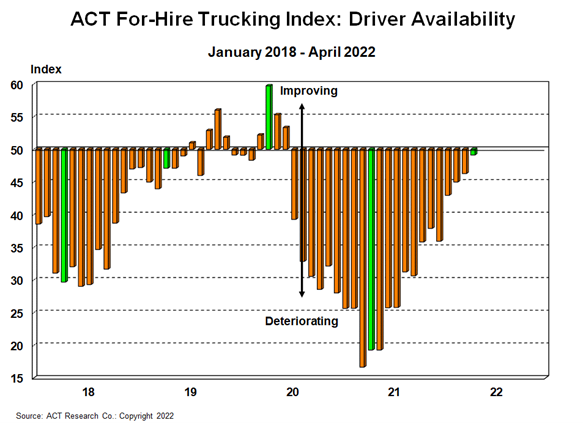
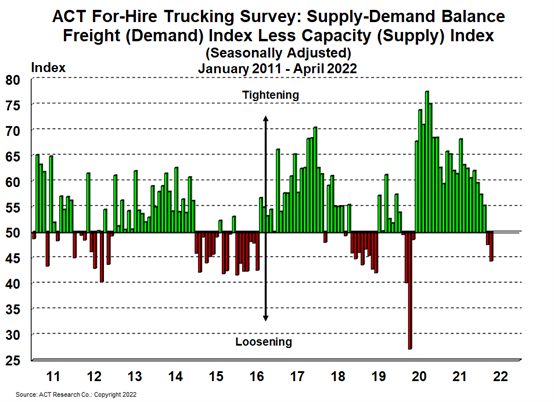
Now that the pendulum has begun to swing, “how bad?” and “how long?” have become some of the most crucial questions. The ACT Freight Forecast report provides monthly, quarterly, and annual predictions for the TL, LTL, and intermodal markets, including capacity, volumes, and rates. The report provides monthly updates of forecasts for the shipments component of the Cass Freight Index and the Cass Truckload Linehaul Index through 2024, as well as DAT spot rates by trailer type, including and excluding fuel surcharges.
Release date: We strive to release our indexes on the 12th of each month. When this falls on a Friday or weekend, our goal is to publish on the next business day.

Tim Denoyer joined ACT Research in 2017, after spending fifteen years in equity research focused primarily on the transportation, machinery, and automotive industries. Tim is a senior analyst leading ACT’s team transportation research effort, and the primary author of the ACT Freight Forecast, U.S. Rate and Volume Outlook. Research associate Carter Vieth, who joined ACT in early 2020 after graduating from Indiana University, also contributes to the report. This report provides supply chain professionals with better visibility on the future of pricing and volume in trucking, the core of the $800 billion U.S. freight transportation industry, including truckload, less-than-truckload, and intermodal.
Tim also plays roles in ACT Research’s core Class 4-8 commercial vehicle data analysis and forecasting, in powertrain development, such as electrification analysis, and in used truck valuation and forecasting. Tim has supported or led numerous project-based market studies on behalf of clients in his four years with ACT Research on topics ranging from upcoming emissions and environmental regulations to alternative powertrain cost analyses to e-commerce and last-mile logistics to autonomous freight market sizing.
ACT’s freight research service leverages ACT’s expertise in the supply side economics of transportation and draws upon Tim’s background as an investment analyst, beginning at Prudential and Bear Stearns. Tim was a co-founder of Wolfe Research, one of the leading equity research firms in the investment industry. While with Wolfe, Tim was recognized in Institutional Investor’s survey of investors as a Rising Star analyst in both the machinery and auto sectors. His experience also includes responsibility for covering the industrial sector of the global equity markets, including with leading investment management company Balyasny Asset Management.
The material contained herein is intended as general industry commentary. The Cass Freight Index, Cass Truckload Linehaul Index (“Indexes”), and other content are based upon information that we consider reliable, but Cass does not guarantee the accuracy, timeliness, reliability, continued availability or completeness of any information or underlying assumptions, and Cass shall have no liability for any errors, omissions or interruptions. Any data on past performance contained in the Indexes is no guarantee as to future performance. The Indexes and other content are not intended to predict actual results, and no assurances are given with respect thereto. Cass makes no warranty, express or implied. Opinions expressed herein as to the Indexes are those of Stifel and may differ from those of Cass Information Systems Inc. All opinions and estimates are given as of the date hereof and are subject to change.
© Copyright 2023 Cass Information Systems, Inc.